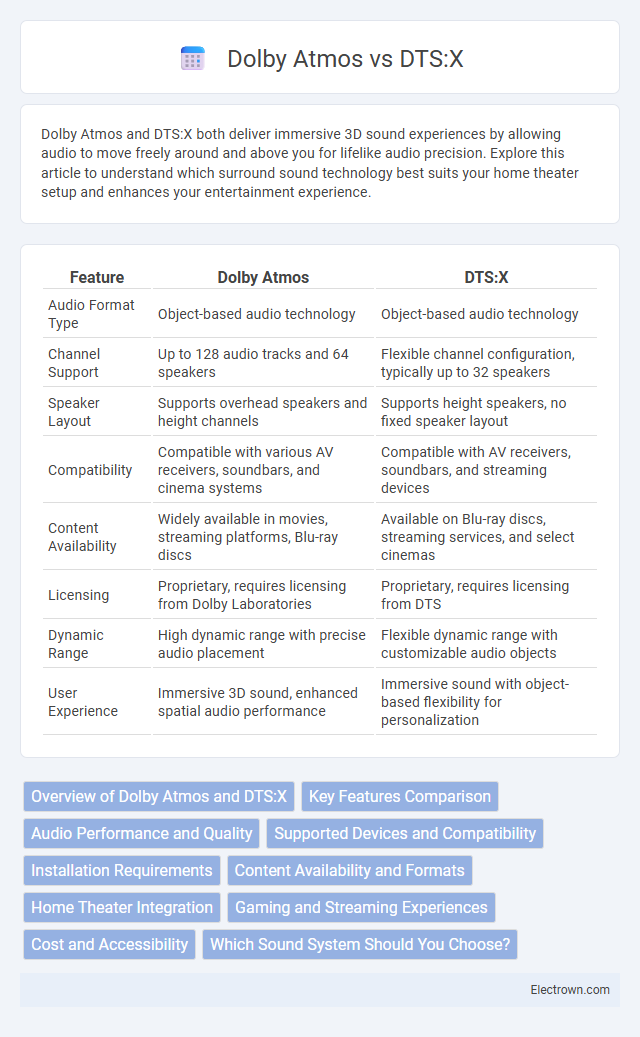Dolby Atmos and DTS:X both deliver immersive 3D sound experiences by allowing audio to move freely around and above you for lifelike audio precision. Explore this article to understand which surround sound technology best suits your home theater setup and enhances your entertainment experience.
Table of Comparison
| Feature | Dolby Atmos | DTS:X |
|---|---|---|
| Audio Format Type | Object-based audio technology | Object-based audio technology |
| Channel Support | Up to 128 audio tracks and 64 speakers | Flexible channel configuration, typically up to 32 speakers |
| Speaker Layout | Supports overhead speakers and height channels | Supports height speakers, no fixed speaker layout |
| Compatibility | Compatible with various AV receivers, soundbars, and cinema systems | Compatible with AV receivers, soundbars, and streaming devices |
| Content Availability | Widely available in movies, streaming platforms, Blu-ray discs | Available on Blu-ray discs, streaming services, and select cinemas |
| Licensing | Proprietary, requires licensing from Dolby Laboratories | Proprietary, requires licensing from DTS |
| Dynamic Range | High dynamic range with precise audio placement | Flexible dynamic range with customizable audio objects |
| User Experience | Immersive 3D sound, enhanced spatial audio performance | Immersive sound with object-based flexibility for personalization |
Overview of Dolby Atmos and DTS:X
Dolby Atmos delivers an immersive audio experience through object-based sound technology, enabling precise sound placement in a three-dimensional space, enhancing home theaters and cinemas alike. DTS:X offers flexible, channel-based audio that adapts dynamically to speaker configurations, providing customizable spatial audio tailored to user preferences. Both formats support height channels and aim to create realistic, enveloping soundscapes for an enhanced viewing experience.
Key Features Comparison
Dolby Atmos offers up to 128 audio tracks and 64 unique speaker feeds, providing precise object-based sound placement and immersive 3D audio experiences with height channels. DTS:X supports flexible speaker layouts without fixed channel requirements, delivering dynamic, object-based audio that adapts to the playback environment for stronger surround sound immersion. Both formats prioritize spatial accuracy and sound object movement, but Dolby Atmos is widely favored for its extensive device compatibility and content availability.
Audio Performance and Quality
Dolby Atmos delivers immersive, three-dimensional sound by utilizing object-based audio technology and overhead speakers, offering precise spatial placement and enhanced clarity in both movies and music. DTS:X provides flexible audio performance with dynamic sound positioning and adaptability to various speaker configurations, emphasizing natural dialogue and spatial realism. Both formats support high-definition audio, but Dolby Atmos often excels in cinematic environments with more widespread content compatibility and advanced rendering techniques.
Supported Devices and Compatibility
Dolby Atmos is widely supported on a variety of devices, including most modern AV receivers, soundbars, home theater systems, and streaming services, ensuring broad compatibility across different platforms. DTS:X is compatible with many AV receivers and home theater setups but tends to have slightly less widespread device support compared to Dolby Atmos. Your choice may depend on the specific hardware and streaming services you use, as Dolby Atmos often offers better integration with popular devices and content providers.
Installation Requirements
Dolby Atmos installation requires ceiling speakers or upward-firing speakers to create immersive overhead sound, alongside standard surround speakers, often necessitating precise speaker placement and compatible AV receivers. DTS:X offers more flexible installation with no specific height speaker requirements, adapting audio to the existing speaker layout by utilizing object-based audio processing for immersive effects. Both systems demand AV receivers with supported decoding capabilities, but Dolby Atmos typically involves higher hardware investment due to its structured speaker configuration.
Content Availability and Formats
Dolby Atmos boasts wider content availability across streaming platforms, Blu-ray discs, and gaming, supporting up to 128 audio tracks and 64 unique speaker feeds for immersive soundscapes. DTS:X offers flexible object-based audio suitable for various speaker configurations, with growing presence in Blu-ray releases and select streaming services, though its library remains smaller than Dolby Atmos. Both formats support backward compatibility, but Dolby Atmos leads in widespread adoption and diverse content formats.
Home Theater Integration
Dolby Atmos and DTS:X both offer immersive home theater integration with object-based audio technology that delivers precise sound placement and movement, enhancing the cinematic experience. Dolby Atmos is widely supported by major AV receivers and streaming services, providing compatibility with numerous speakers and soundbars for customizable setups. You can choose DTS:X for its flexibility in speaker configuration and natural sound profiling, which adapts well to diverse room acoustics and speaker layouts.
Gaming and Streaming Experiences
Dolby Atmos delivers immersive, three-dimensional audio that enhances gaming by providing precise sound localization, making it easier to detect enemies and environmental cues. DTS:X offers flexible object-based audio that adapts to your speaker setup, improving streaming experiences with clear dialogue and dynamic soundscapes across various devices. For gamers and streamers, choosing Dolby Atmos or DTS:X depends on your preference for spatial accuracy versus customization in audio playback.
Cost and Accessibility
Dolby Atmos systems often come at a higher price point due to licensing fees and widespread adoption in premium home theaters and cinemas, making them more accessible in mainstream devices like soundbars and AV receivers. DTS:X offers a more cost-effective alternative with flexible speaker configurations and open licensing, which can lower overall setup costs but may be less prevalent in retail products. Your choice between Dolby Atmos and DTS:X should consider the budget constraints and availability of compatible devices to ensure the best immersive audio experience within your spending range.
Which Sound System Should You Choose?
Dolby Atmos delivers immersive, object-based audio with a wide range of compatible content and support across streaming platforms, making it ideal for home theaters seeking precise overhead sound effects. DTS:X offers customizable speaker layouts and a more flexible audio experience, often favored for its high bit-rate encoding and superior bass management in multi-channel setups. Your choice depends on your home audio equipment, content preferences, and whether you prioritize broad compatibility or tailored sound customization.
Dolby Atmos vs DTS:X Infographic

 electrown.com
electrown.com